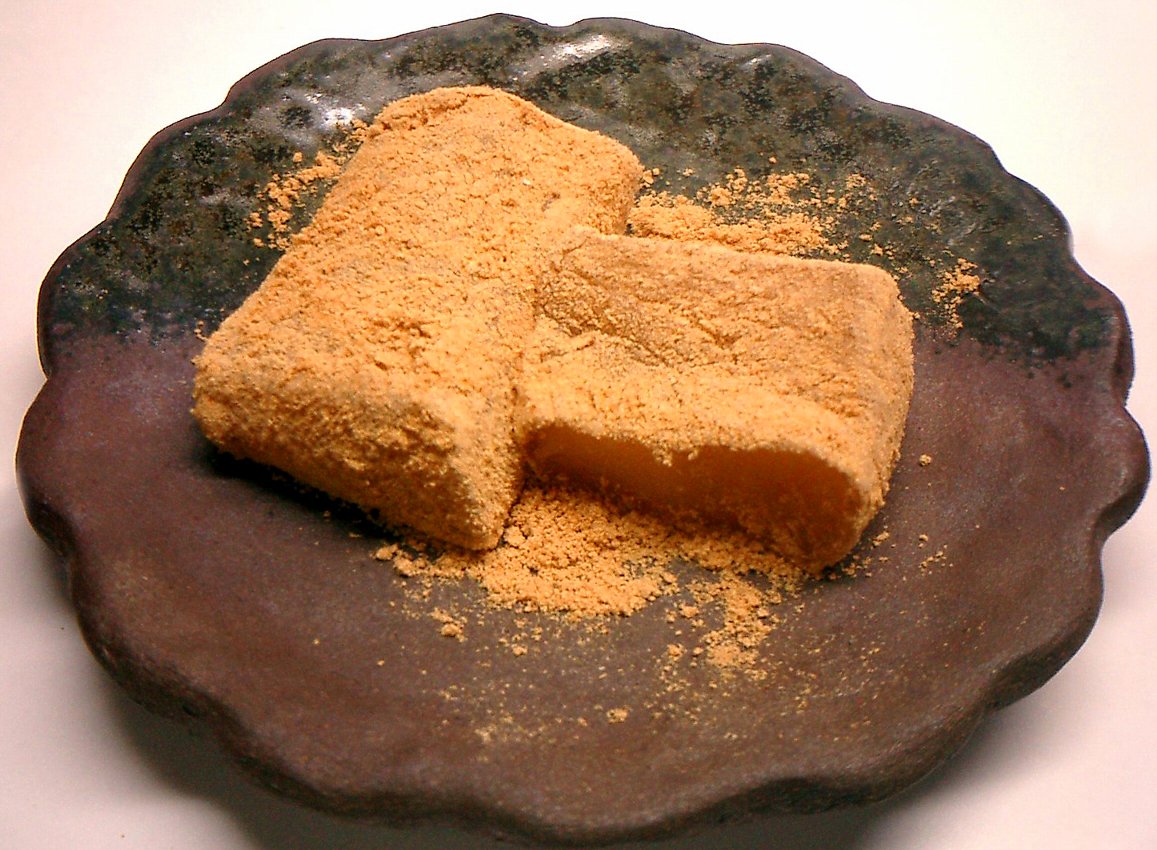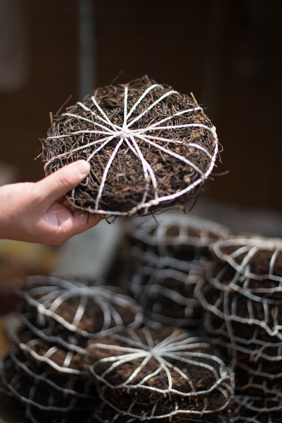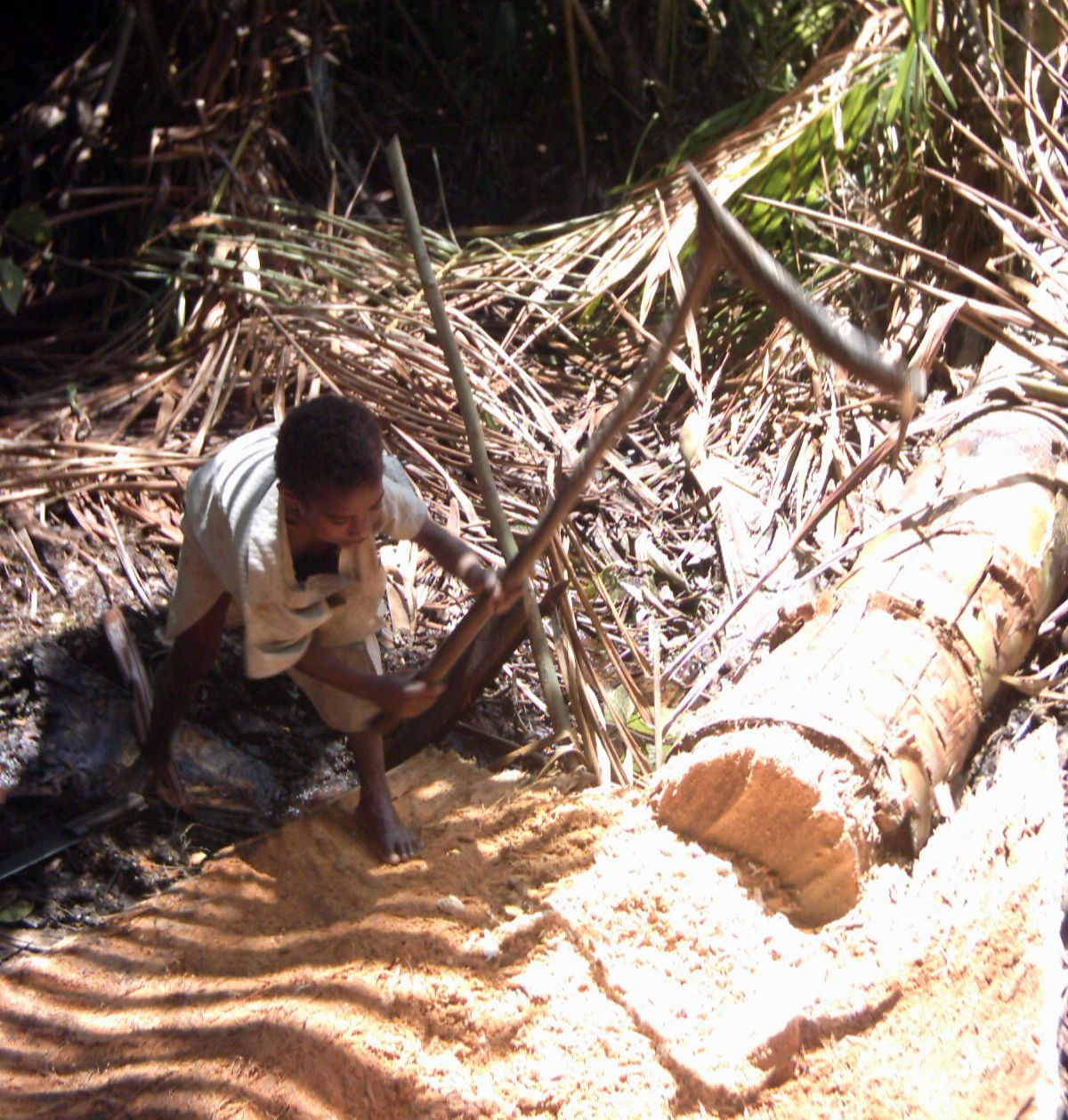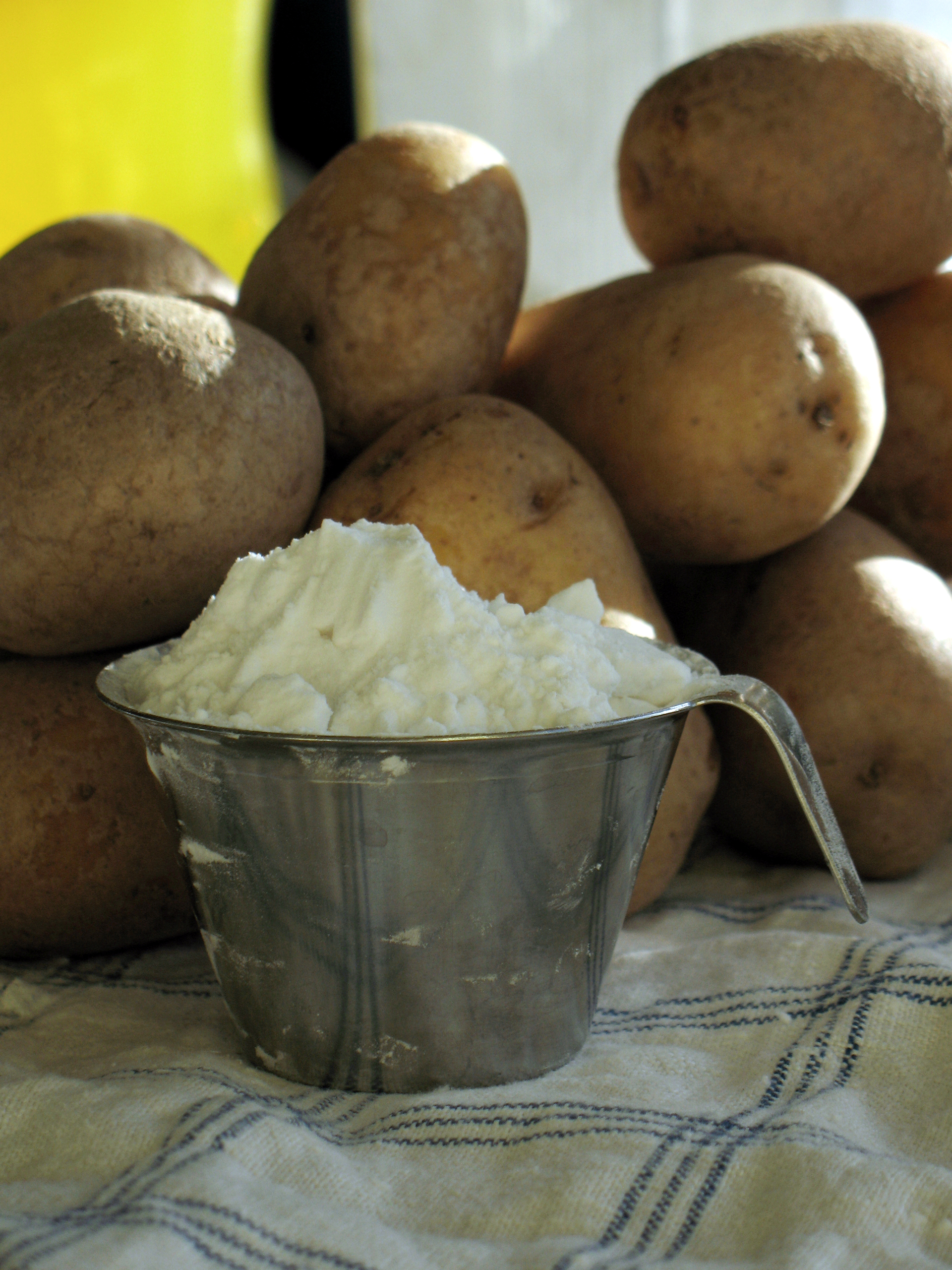|
Warabimochi
is a ''wagashi'' (Japanese confection) made from ''warabiko'' (bracken starch) and covered or dipped in ''kinako'' ( sweet toasted soybean flour). Kuromitsu syrup is sometimes poured on top before serving as an added sweetener. History ''Warabimochi'' is a traditional Japanese dessert that is believed to date back to the Heian period (794-1185) in Japan, when it was a popular delicacy among the aristocracy. It was one of the favorite treats of Emperor Daigo. Hayashi Razan's "''Heishin kikō'' (Travelogue of 1616) .. which is considered to be the first travel diary to mention food on the road," highlighted ''Warabimochi'' as did other Tōkaidō travel guides in the 1600s. The dessert became more widespread during the Edo period (1603-1868) when it was served in tea houses as part of the traditional Japanese tea ceremony. It is now popular in the summertime, especially in the Kansai region and Okinawa, and it is often sold from trucks, similar to an ice cream truck in Western ... [...More Info...] [...Related Items...] OR: [Wikipedia] [Google] [Baidu] |
Kinako
''Kinako'' ( or "yellow flour") is roasted Soy flour, soybean flour, used in Japanese cuisine. In English, it is usually called "roasted soy flour". ''Kinako'' is mostly used as a topping to flavor rice cakes like mochi. History Usage of the word ''kinako'' appeared in Japanese cookbooks from the late Muromachi period (1336–1573). An early record of the word comes from the text ''Sōtan Chakai Kondate Nikki'' (''Sōtan's Tea Ceremony Cookery Menu Diary''), written in 1587 by Sen no Sōtan, a Japanese tea ceremony, tea ceremony master. Production ''Kinako'' is produced by finely grinding roasted soybeans into powder. The skin of the soybean is typically removed before pulverizing the beans, but some varieties of ''kinako'' retain the roasted skin. Yellow soybeans produce a yellow ''kinako'', and green soybeans produce a light-green product. Usage ''Kinako'' is widely used in Japanese cooking, but is strongly associated with ''dango'' and ''wagashi''. ''Dango'', dumplin ... [...More Info...] [...Related Items...] OR: [Wikipedia] [Google] [Baidu] |
Bracken
Bracken (''Pteridium'') is a genus of large, coarse ferns in the family (biology), family Dennstaedtiaceae. Ferns (Pteridophyta) are vascular plants that undergo alternation of generations, having both large plants that produce spores and small plants that produce gamete, sex cells (eggs and sperm) in its life cycle. Brackens are noted for their large, highly divided leaves. They are found on all continents except Antarctica and in all environments except deserts, though their typical habitat is moorland. The genus probably has the widest distribution of any fern in the world. The word ''bracken'' is of Old Norse origin, related to Swedish ''bräken'' and Danish ''bregne'', both meaning fern. In the past, the genus was commonly treated as having only one species, ''Pteridium aquilinum'', but the recent trend is to subdivide it into about ten species. Like other ferns, brackens do not have seeds or fruit, but reproduce by spores. The immature fronds, known as ''fiddleheads'', ar ... [...More Info...] [...Related Items...] OR: [Wikipedia] [Google] [Baidu] |
Mochi
A mochi ( ; Japanese ) is a Japanese rice cake made of , a short-grain Japonica rice, japonica glutinous rice, and sometimes other ingredients such as water, sugar, and cornstarch. The steamed rice is pounded into paste and molded into the desired shape. In Japan, it is traditionally made in a ceremony called . While eaten year-round, mochi is a traditional food for the Japanese New Year, and is commonly sold and eaten during that time. Mochi is made up of polysaccharides, Clofibrate, lipids, protein, and water. Mochi has a varied structure of amylopectin gel, starch grains, and air bubbles. In terms of starch content, the rice used for mochi is very low in amylose and has a high amylopectin level, producing a gel-like consistency. The protein content of the japonica rice used to make mochi is higher than that of standard short-grain rice. Mochi is similar to , which is made with rice flour instead of pounded rice grains. History Red rice was the original variant used in ... [...More Info...] [...Related Items...] OR: [Wikipedia] [Google] [Baidu] |
Kansai Region
The or the lies in the southern-central region of Japan's main island Honshū. The region includes the prefectures of Nara, Wakayama, Kyoto, Osaka, Hyōgo and Shiga, often also Mie, sometimes Fukui, Tokushima and Tottori. The metropolitan region of Osaka, Kobe and Kyoto ( Keihanshin region) is the second-most populated in Japan after the Greater Tokyo Area. Name The terms , , and have their roots during the Asuka period. When the old provinces of Japan were established, several provinces in the area around the then-capital Yamato Province were collectively named Kinai and Kinki, both roughly meaning "the neighbourhood of the capital". Kansai (literally ''west of the tollgate'') in its original usage refers to the land west of the Osaka Tollgate (), the border between Yamashiro Province and Ōmi Province (present-day Kyoto and Shiga prefectures).Entry for . Kōjien, fifth edition, 1998, During the Kamakura period, this border was redefined to include Ōmi a ... [...More Info...] [...Related Items...] OR: [Wikipedia] [Google] [Baidu] |
Kuromitsu
is a Japanese sugar syrup. It is similar to molasses, but thinner and milder. It is typically made from unrefined (muscovado sugar), and is a central ingredient in many Japanese sweets. It is one of the ingredients used in making , and is eaten with , fruit, ice cream, and other confectionery. See also * List of syrups References Sources * Taste of Zen: kuromitsu recipe Japanese cuisine Syrup {{Japan-cuisine-stub ... [...More Info...] [...Related Items...] OR: [Wikipedia] [Google] [Baidu] |
Matcha
is a finely ground powder of green tea specially processed from shade-grown tea leaves. Shade growing gives matcha its characteristic bright green color and strong umami flavor. Matcha is typically consumed suspended in hot water. Matcha originated in China, but the production of the raw material for matcha was banned in China in the 14th century. Shade growing was invented in Japan in the 16th century and most matcha is produced there today. The traditional Japanese tea ceremony, typically known as or , centers on the preparation, serving and drinking of matcha as hot tea, and embodies a meditative and spiritual practice. Matcha is also used to flavor and dye foods such as ''mochi'' and ''soba'' noodles, green tea ice cream, matcha lattes, and a variety of Japanese ''wagashi'' confectionery. For this purpose, matcha made green by color additives instead of expensive shade-grown matcha is often used. Definition Strict definitions of matcha are given by the International O ... [...More Info...] [...Related Items...] OR: [Wikipedia] [Google] [Baidu] |
Sago
Sago () is a starch extracted from the pith, or spongy core tissue, of various tropical palm stems, especially those of ''Metroxylon sagu''. It is a major staple food for the lowland peoples of New Guinea and the Maluku Islands, where it is called ''saksak'', ''rabia'' and ''sagu''. The largest supply of sago comes from Melanesia region, particularly Eastern Indonesia. Large quantities of sago are sent to Europe and North America for cooking purposes. It is traditionally cooked and eaten in various forms, such as rolled into balls, mixed with boiling water to form a glue-like paste (Papeda (food), papeda), or as a pancake. Sago is often produced commercially in the form of "pearls" (small rounded starch aggregates, partly Starch gelatinization, gelatinized by heating). Sago pearls can be boiled with water or milk and sugar to make a sweet sago pudding. Sago pearls are similar in appearance to the pearled starches of other origin, e.g. cassava starch (tapioca) and potato starch ... [...More Info...] [...Related Items...] OR: [Wikipedia] [Google] [Baidu] |
Potato Starch
Potato starch is starch extracted from potatoes. The cells of the root tubers of the potato plant contain leucoplasts (starch grains). To extract the starch, the potatoes are crushed, and the starch grains are released from the destroyed cells. The starch is then left to settle out of solution or separated by Hydrocyclone, hydrocyclones, then dried to powder. Potato starch contains typical large oval spherical granules ranging in size from 5 to 100 Micrometre, μm. Potato starch is a refined starch, containing minimal protein or fat. This gives the powder a clear white colour, and the cooked starch typical characteristics of neutral taste, good clarity, high binding strength, long texture, and minimal tendency to foaming or yellowing of the solution. Potato starch contains approximately 800 Parts per million, ppm phosphate bound to the starch; this increases the viscosity and gives the solution a slightly anionic character, a low starch gelatinization, gelatinisation temperat ... [...More Info...] [...Related Items...] OR: [Wikipedia] [Google] [Baidu] |
Ice Cream Truck
An ice cream van (English in the Commonwealth of Nations, Commonwealth English) or ice cream truck (North American English) is a commercial vehicle that ice cream products are sold from, usually during the spring and summer. Ice cream vans are often used for Hawker (trade), street vending and drive through residential areas and park at parks, beaches, or other areas where people congregate. Ice cream vans often have decorations, a serving window on the kerbside, and a display of available products and their prices. Most ice cream vans are independently owned and operated. However, there are ice cream van franchises such as Mister Softee. A distinctive feature of ice cream vans (in comparison to other kinds of food trucks) is their sound devices, used to attract attention. Some use a bell or a set of bells that is rung while some use a horn loudspeaker which amplified music is played from. Some ice cream vans use both of these sound devices. The amplified music played by ice ... [...More Info...] [...Related Items...] OR: [Wikipedia] [Google] [Baidu] |
Okinawa Prefecture
is the southernmost and westernmost prefecture of Japan. It consists of three main island groups—the Okinawa Islands, the Sakishima Islands, and the Daitō Islands—spread across a maritime zone approximately 1,000 kilometers east to west and 400 kilometers north to south. Despite a modest land area of 2,281 km² (880 sq mi), Okinawa’s territorial extent over surrounding seas makes its total area nearly half the combined size of Honshu, Shikoku, and Kyushu. Of its 160 Island, islands, 49 are inhabited. The largest and most populous island is Okinawa Island, which hosts the capital city, Naha, as well as major urban centers such as Okinawa (city), Okinawa, Uruma, and Urasoe, Okinawa, Urasoe. The prefecture has a subtropical climate, characterized by warm temperatures and high rainfall throughout the year. People from the Ryukyu Islands, Nansei Islands, including Okinawa Island, Okinawa, the Sakishima Islands, and parts of Kagoshima Prefecture, are often collectively referred ... [...More Info...] [...Related Items...] OR: [Wikipedia] [Google] [Baidu] |
Tōkaidō (road)
The , which roughly means "eastern sea route," was the most important of the Edo Five Routes, Five Routes of the Edo period in Japan, connecting Kyoto to the ''de facto'' capital of Japan at Edo (modern-day Tokyo). Unlike the inland and less heavily travelled Nakasendō, the Tōkaidō travelled along the sea coast of eastern Honshū, hence the route's name. The Tōkaidō was first used in ancient times as a route from Kyoto to central Honshu before the Edo period. Traveling the Tōkaidō Most of the travel was on foot, as wheeled carts were almost nonexistent, and heavy cargo was usually sent by boat. Members of the higher class, however, traveled by ''kago''. Women were forbidden from travelling alone and had to be accompanied by men. Other restrictions were also put in place for travelers, but, while severe penalties existed for various travel regulations, most seem not to have been enforced. Captain Sherard Osborn, who traveled part of the road in around 1858, noted that: ... [...More Info...] [...Related Items...] OR: [Wikipedia] [Google] [Baidu] |






